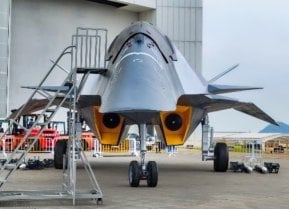The Columbia-Class Submarine Nightmare Summed Up in 4 Words
The U.S. Navy’s Columbia-class nuclear-powered ballistic missile submarine program is facing critical challenges, delaying its intended operational debut. These include significant cost overruns, manufacturing delays, and systemic inefficiencies in America’s shipyards. The late delivery of essential components, such as the bow dome and turbine generators, highlights the program's struggles.
Disaster In the Making: The U.S. Navy’s Columbia-class nuclear-powered ballistic missile submarine program is facing critical challenges, delaying its intended operational debut. These include significant cost overruns, manufacturing delays, and systemic inefficiencies in America’s shipyards. The late delivery of essential components, such as the bow dome and turbine generators, highlights the program's struggles.

Workforce shortages and unresolved supplier investments further hinder progress.
The complexity of the Columbia-class, labeled by the GAO as the Navy’s “most complex submarine,” underscores these challenges, risking U.S. naval readiness at a time of increasing global threats.
The Navy's New Problem: The Columbia-Class Submarine
The United States Navy is in hot water when it comes meeting the deadlines and obligations of their contracts for new systems, such as the Columbia-class nuclear-powered ballistic missile submarines, which the Government Accountability Office (GAO) has correctly labeled as the “most complex submarine in [the US Navy’s] history.”
In fact, the complexity of these subs is one of the biggest hindrances for the Navy to meet its desired end goals with the program (they plan to receive delivery of the first submarine of this class by April 2027).
In fact, the GAO was even more caustic in its report on the Columbia-class submarine. According to that GAO report, “The Navy lacks insight into the program’s schedule because the shipbuilder hasn’t conducted a schedule risk analysis, which can help identify and manage risks to achieving planned delivery dates.” In other words, this boat is never hitting the Deep Blue Sea.
Here are the top five reasons for why the Columbia-class submarine isn’t going anywhere anytime soon.
5. Massive Cost Overruns
The USS Columbia, the namesake of the new class of submarine that is supposed to replace the Virginia-class submarines, is now expected to be hundreds of billions of dollars more than what was originally anticipated.
Indeed, because of the costs of this first unit, it is unlikely that the 2027 deployment deadline will be met.
What’s more, this will, in turn, drastically raise the cost of all submarines in the Columbia family.

4. Taking Their Sweet Time
As a result of the cost overruns and subsequent deadline overruns, the submarines will be utterly useless until they can actually get out of the shipyard. Specifically, there are two delays that are complicating the construction of the Columbia-class submarines.
The first is the bow dome. A bow dome is a sonar dome that’s mounted on the bow of a submarine and contains the submarine’s all-important sonar transducers. This feature is key for the stealth capabilities of the submarine. The bow dome is not estimated to be delivered until next June (that’s more than 12 months late).
Then the turbine generators are an astonishing four years late. This system forms a critical component for the submarine’s power system.
It provides electricity to run the submarine’s propulsion system, electrical systems, and other equipment. If the submarine doesn’t have this system, then it doesn’t work.
And it’s significantly delayed.
3. America’s Broken Shipyards Haunting the Program
For decades, the United States’ military shipyards have been little more than failure factories. America’s shipyards have struggled to maintain readiness for the existing fleet let alone keep up with demand for newer systems, such as the Columbia-class submarine.
The Navy, as per the GAO report from last year, is not overseeing the program very well which is leading to slow and poor work delivery.
At the same time, the materials needed to build the actual submarines, because of the supply chain issues, are not readily available. In all, the shipyards are not—and likely will not—meet the expectations of the Navy.
2. Who Will Build the Submarines?
Another issue that is related to the ongoing shipbuilding crisis in the United States is the workforce/human capital problem. Shipbuilders are chronically understaffed and their workforce is often spread too thin.
What’s more, these shipbuilders are struggling to keep talent onboard long enough to complete important tasks.
1. Downrange Problems
Evoking the GAO report yet again, the Navy has failed to define how investments in their supplier base will increase production or generate cost savings. Basically, the entire Columbia program is beset by the same problems that the overall Navy shipbuilding programs encounter.
As time goes on, the problems are worsening. The longer it takes to correct these problems, the less likely it will be that the US Navy will ever be able to produce the systems and weapons needed to survive and thrive in the current dynamic global threat environment.
The Columbia-class is not going to make it to sea anytime soon and the United States Navy’s readiness will again be weakened.
About the Author
Brandon J. Weichert, a National Interest national security analyst, is a former Congressional staffer and geopolitical analyst who is a contributor at The Washington Times, the Asia Times, and The-Pipeline. He is the author of Winning Space: How America Remains a Superpower, Biohacked: China’s Race to Control Life, and The Shadow War: Iran’s Quest for Supremacy. His next book, A Disaster of Our Own Making: How the West Lost Ukraine, is available for purchase wherever books are sold. Weichert can be followed via Twitter @WeTheBrandon.
Image Credit: Creative Commons.


